Fattet hummus is one of different fatteh dishes in the Levantine cuisine. All these dishes are based on having fried pieces of pita bread topped with different toppings… I don’t know how exactly to translate the word “fatteh” to English but I will try to explain it. “Fatteh” is dialect Arabic word comes from the verb “fa-tta” that means to crumble bread into small pieces. It is mostly used as a name of these type of dishes.
Fattet hummus (also called “tis-iyeh” as in Syria) is typically served as breakfast, mostly on Friday’s breakfasts. Also it’s served as a side dish in occasional dinners.
There are many recipes of fattet hummus, but I’m going to share with you the best of them all. It consists of four layers: Fried pita bread, Tahini sauce, tahini paste (hummus dip) and topping of pine nuts, olive oil, parsley and cumin.
Ingredients
- 500 grams chickpeas, dried (soaked in water overnight)
- 3 small loaves of pita bread, cut into bite-sized squares
- 1/4 cup vegetable oil (optional)
- Salt to taste
- 1 tablespoon cumin, divided
- 3/4 cup tahini paste, divided
- 1.5 lemon, squeezed , divided
- 4 tablespoon olive oil
- 3 tablespoon pine nuts
- 2 tablespoon parsley, chopped
Directions:
In a cooking pan, add soaked chickpeas and cover them completely with water. Cover the pan and place it over a medium heat for about an hour until it becomes tender and completely cooked. (Using canned chickpeas speeds up the process; it doesn't need to be soaked. All what you need to do is to cook them with water until it’s boiling.)
Meanwhile and in a different frying pan, heat vegetable oil, add pita bread pieces and deeply fry them and keep stirring for about 5 minutes or until they become brown-golden and crunchy. (Although frying pita bread is not very common in Palestinian fatteh; but it gives the best results. Palestinian way suggests using any kind of sponge bread without frying or roasting)
Place bread pieces in a large and deep serving dish (you may use more than one dish as I did here). Add about 5 to 6 full tablespoon of cooked chickpeas along with some chickpea broth. Add small pinches of salt and cumin.
For tahini sauce: Place one cup of cooked chickpeas in a blender. Add 1.5 cups of chickpea broth, 3/4 tablespoon cumin, salt, juice of one lemon, and 1/2 cup tahini. Blend them very well. Pour tahini sauce over fried bread.
For hummus paste: Place remaining chickpeas in the same blender (leave very small amount for topping). Add half cup of chickpea broth, salt, 1/4 tablespoon cumin, juice of half lemon and 1/4 cup tahini and blend. Using a spoon, add the creamy paste and spread then in the serving dish.
Fry pine nuts with olive oil on a medium heat until they become golden. For topping: Add chickpeas, parsley, a pinch of cumin, and fried pine nuts along with olive oil. Serve hot.


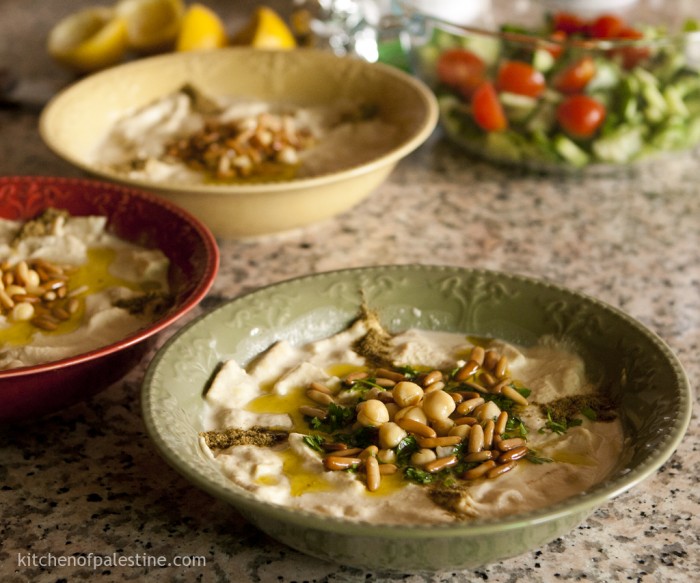
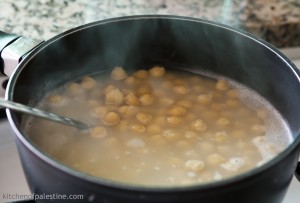
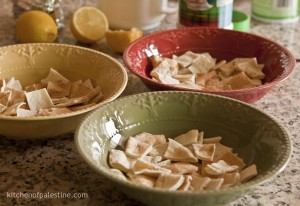
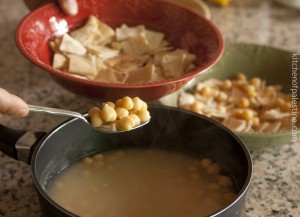
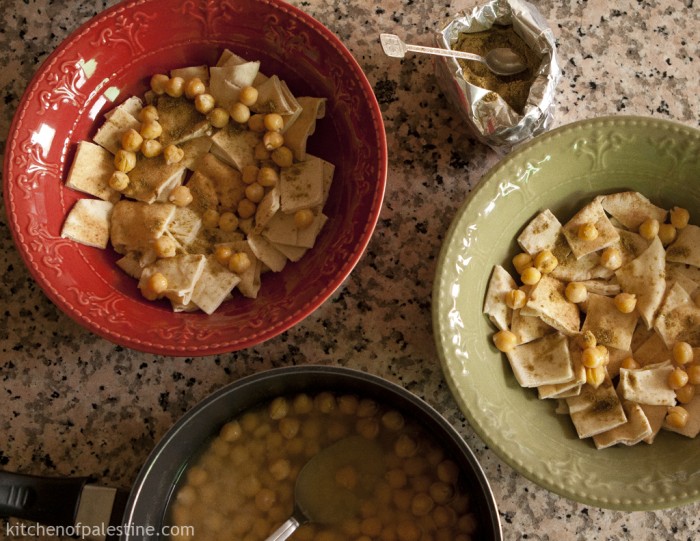
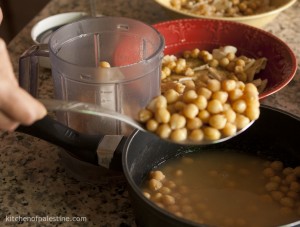
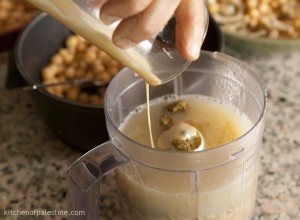
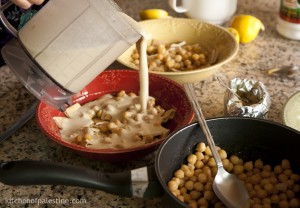
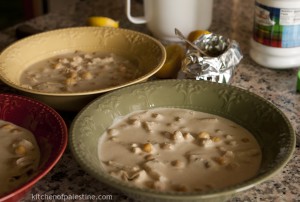
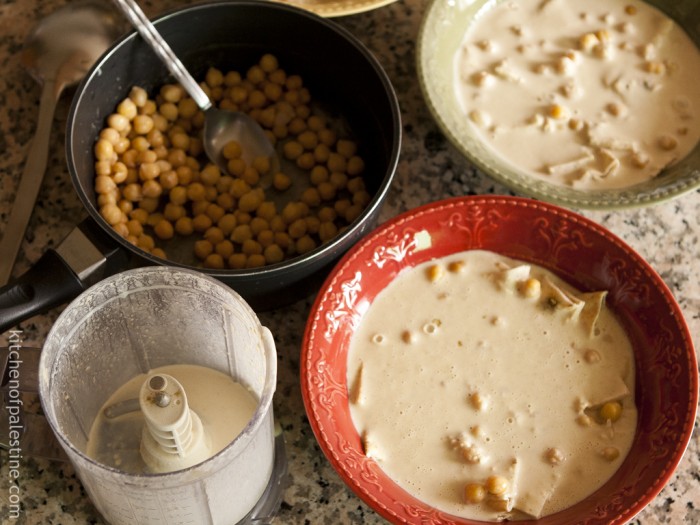
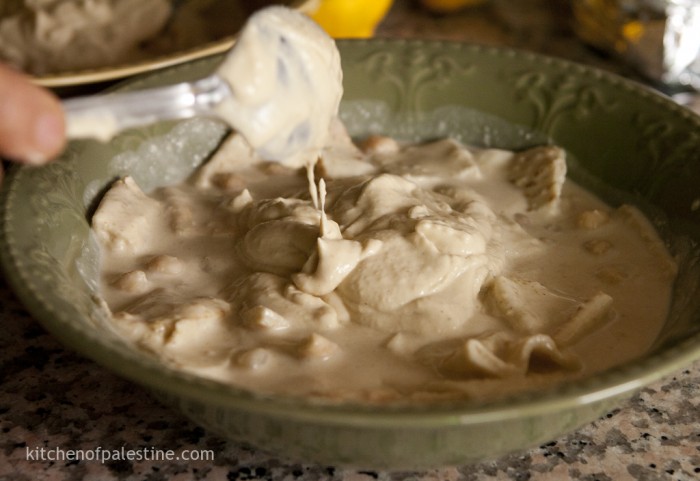
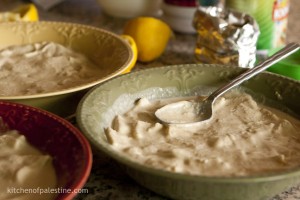
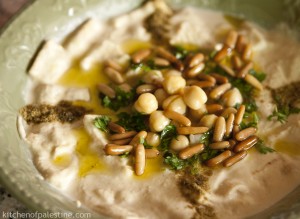


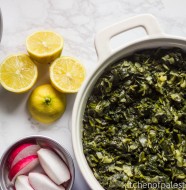
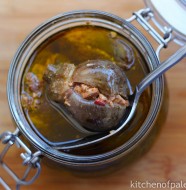
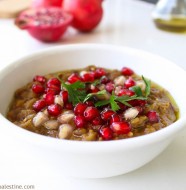

A breakfast fit for a king! This dish looks absolutely amazing and I just can’t wait to try it. Thank you so much for sharing the recipe with so many helpful pictures.
And I can’t wait to hear your feedback.. Thank you so much for your supportive comment. Really appreciated! :)
Hello! I love your blog, cant wait to see more recipes from you!!! :)
Thank you so much Svetlana :) more recipes are coming every week..
is this eaten with more bread or how?
Like other fatteh dishes, it’s eaten with a spoon or a fork.
I wish to make this for someone from Palestine
who craves the dish, but has ABSOLUTELY no
idea of cooking.
If you use canned chick peas, is there enough broth? There are 2 or 3 additions of cumin and lemon juice — is this too sour?
How do you heat this to serve? In the oven, the micro – or just assemble when things are warm?
What should it be served with? Does one person
have their own bowl or is it a share food? Sorry for so many questions, but this is not my cuisine.
I use canned chickpeas when I’m on a hurry so that should be fine. Make sure broth completely covers chickpeas, add some water if necessary.
It’s preferably to be assembled on the spot when it is to be served. Quantity above serves 4 to 5 persons.
And it’s not very sour, similar to hummus flavor.
It can be a side dish (share food) or a main dish (everyone has it’s own bowl), in this case it can be served with vegetables salad (tomatoes, cucumber, olives and olive oil)…
It’s an easy recipe and results are always guaranteed :) let me know how it goes..
I will never recommend canned food in any form, I’m Palestinian/Syrian because the sodium for one reason and I buy NON-GMO organic garbanzo beans taste completely better. I order them from Amazon. IF for lazy person to use can, you should wash the beans for hummus which you can add water if needed, but for fatteh the best is home made cooking saving the real infused water.
The bread should be dry as the old days they used to break the one day old bread. Today just cut small and bake them for little bit – no frying it will be too greasy heavy. Nice pictures though.
For Lynne, (( I wish to make this for someone from Palestine)). Most Palestinian men know how to cook, he should spoil you and cook it for you IF that some one is he :)
Nice blog Eman..
Thank you NS for your comment. I agree! Canned food should be the last option. The thing is dried chickpeas are not always available in every supermarket.. Washing canned chickpeas before using them, good tip. I’ll add it to the post.
As for bread, yes it can be roasted, old, or even fresh (as my mom prefers it). But I like it fried :)
Thanks again, looking forward for more tips from you :)
Actually this dich is made from old bread like fatoosh.People didn’t want to throw it away so they found such recipes !It was poor people food !
Hi, I was in Jordan last year and tried Fattet Hummus and LOVED IT, and I haven’t seen it at a Middle Eastern restaurant since then, so I’m very excited that I found your recipe for it. I have a question though. Many of the other recipes I’ve looked at call for yogurt and yours doesn’t, why is that? (The Fattet that I so fondly remember/ want to replicate is the one I tried in Hashem while in Amman)
Thanks a lot!
Some recipes call for yogurt in order to lighten the tahini’s flavor and texture. I don’t add it because I enjoy the rich taste of tahini, so it’s totally up to.
I’ve been living in Amman for more than 15 years and I’ve never been to Hashem, can you beleive it! I don’t think that they use yogurt and they probably use sponge bread instead of fried pita bread.
I’ve tried many recipes but this one beats all others ;) try it out and tell me how it goes!
Eman,
Thanks for the explanation! I made it last weekend just as you said (I also love the rich taste of Tahini!) and my family LOVED it!! I hadn’t tried it with the fried pita and liked it much more than with sponge bread- and I didn’t think Fattet could get any better!
I am so surprised you haven’t been to Hashem! Maybe it’s a tourist thing? I don’t know, but I loved it! and the knafeh close-by at Habibeh was by far the best knafeh I had in Jordan! If you haven’t been you need to go! You’re lucky, Jordan’s food is wonderful, I can’t wait to try more of your recipes :)
Just discovered your beautiful blog. Perfect recipe!!!!! Made it and it was Very yummy :-))also made the Zatar fatayer!! Also phenomenal:-). thank you for sharing and for the detailed pictures and instructions!!
Ohhh am dying
I love fattet and eat it every time i go to Hashem in Riyadh. Thanks for the detailed recipe.Cheers. Love the blog
Wow, wonderful blog structure! How lengthy have you ever been running a blog for?
you made running a blog look easy. The total look of your web
site is excellent, as smartly as the content! You can see similar:
sklep and here sklep
Elf Bar Disposable Vape provides effortless vaping pleasure with its compact design and variety of flavors. Enjoy the convenience of a disposable device without compromising on taste or satisfaction.
Its such as you read my thoughts! You seem to understand so much about this, like
you wrote the guide in it or something. I believe that you just could do with some percent to power the message home a bit, but other than that, that is great blog.
An excellent read. I will definitely be back.
I saw similar here: Dobry sklep
I am actually delighted to read this weblog posts which includes
lots of helpful information, thanks for providing such data.
I saw similar here: E-commerce
Wow, incredible blog structure! How long have you been blogging for?
you made running a blog look easy. The whole look
of your website is magnificent, as neatly
as the content! You can see similar here ecommerce
The excellent news is that you could learn to design a ravishing web site by using resources comparable to Lifehacker.com’s free “evening school” for web design. For instance, if I see a superb hyperlink, I can throw it in my weblog. But there is an effective probability you have got never seen a blog (also referred to as a weblog) or experienced the blogosphere. There are individuals who use their blogs merely as a scrapbook — a form of on-line memory. Blogs often include stories or little snippets of knowledge which are attention-grabbing to the writer. Web site. You’ll want to provide information like your full identify, date of start, social security number, and a type of identification. To be able to guess her due date, you might want to enter in the primary date of her final interval, click calculate, and an estimated date of arrival will probably be supplied. But a hacker who accesses your account would not need to vary any information as a way to sap your funds.
Whenever the writer finds a link or a snippet of data that he/she desires to recollect, it gets posted in the weblog. A weblog is often public — the whole world can see it. You can easily perceive the worth and significance. Chatrooms can produce a powerful sense of on-line id leading to impression of subculture. If malicious software program finds its approach into your computer, it could cause chaos, from bombarding you with annoying pop-ups to scanning your gadget for private data. A: The confidentiality of data may vary among astrologers, so it’s essential to debate privateness considerations and confidentiality agreements earlier than sharing private particulars throughout the free chat. HowStuffWorks is like this, with hundreds of information pages all organized beneath a home web page. The classes and all the latest tales are accessed from the house web page. Exactly. A key to this is the result of body language, and ensure they perceive what you might be wanting, needing and looking out, and that you perceive the same about him.
A small business site follows the same format — it might need a home pagÂe and five or 10 sub-pages. Think a couple of “normal Web site.” It normally has a home page, with hyperlinks to numerous sub-pages that have extra detail. If you’ve got ever used dwell assist providers as a buyer, you’ve seen that it is more convenient than calling. The charges could be steeper than in the event you just switch funds between banks, but when wiring isn’t an possibility, these providers are often fast, simple and efficient. If you’re warned early enough and make contact with your financial institution as quickly as attainable, you will help forestall fraudsters from wreaking havoc in your funds. If you employ on-line invoice pay, you may as well join alerts to notify you when a cost has been despatched or scheduled to be sent, fails to course of, or when an computerized cost is about to expire. Lieber, Ron. “Automated Bill Payments are a Cinch (Not So Fast).” The new York Times. Fast ahead a handful of decades and most American shoppers now expect slightly wrangling and some creative reductions and perks together with their purchases. Because the human reminiscence has been known to fail occasionally, you would possibly get pleasure from having little reminders about sure dates.
Banks take time processing transactions, and some, such as debit card purchases, can take a number of days to submit to your account. Hopefully you will not be a victim of fraud, but the peace of mind that comes with such alerts might be reassuring. As an illustration, some banks offer alerts that notify you when a due date for a credit card invoice or utility bill is arising. However, this is to tell you that don’t even try to look for a solution for wanting at the issuance date via different channels and with out having an Absher account. For the most effective outcomes, you may need to search for multiple reviews written about the identical item. Think about it: You’d want the identical treatment. If all people spoke in the same language with the same accent and the same tone of voice, creating the right voice recognition utility can be simple. Online banking has exploded up to now decade, and more and more businesses are recognizing its advantages over conventional banking. Online chat assist software program allows companies to collect and analyze information on customer inquiries and latamdate review interactions. To connect with an IRC server, a person merely wants the right software shopper, and there are free shoppers out there for virtually any working system.
You may have a superb practical experience and keep away from the dangers once you keep on being cautious and bear in mind if a bit of something is too good for being right, it’s not genuine. P.S. If you’re a bit nervous about what to textual content, apply on MeetMe. So if you’re witty, let it shine each in your online dating profile and in your texts. Remember that utilizing colours in some way in your profile will help tremendously. The following infographic guide will aid you improve your relationship results, as will studying my four courting struggles of highly clever males article. Being 21 hours behind made business difficult because having weekends on backward days meant only 4 days of the week had been shared workdays. Government and business issues on opposite sides of the road might solely conduct routine enterprise by radio or phone on the four days of the week which have been weekdays on both sides. During his journey, he had added a full day to his clock, on the rhythm of an hour per fifteen degrees, or four minutes per diploma, as Verne writes. Debate continues inside the Seventh-day Adventist neighborhood in the Pacific as to which day is actually the seventh-day Sabbath.
For this reason, some authorities rule that sure aspects of Sabbath observance are required on Sunday (in Japan and New Zealand) or Friday (in Hawaii and French Polynesia) along with Saturday. Most Seventh Day Adventists in Samoa deliberate to observe Sabbath on Sunday after Samoa’s crossing the IDL in December 2011, but SDA groups in Samatau village and other locations (roughly 300 members) determined to accept the IDL adjustment and observe the Sabbath on Saturday. Christmas for instance, is celebrated on 25 December (in keeping with both the Gregorian or the Julian calendar, relying upon which of the two is used by the particular church) as that date falls in nations located on either aspect of the IDL. The nautical date line, not the identical charmingdate review because the IDL, is a de jure construction determined by worldwide settlement. From this comes the utility and importance of UTC or “Z” (“Zulu”) time: it permits a single common reference for time that’s valid for all points on the globe at the identical second. The amount of time between that first e-mail and a primary in-person date varies from person to individual.
Always create an exit technique in case you feel uncomfortable, threatened, or suspicious throughout your date. In 1867, the United States purchased Russian America and moved the territory to the east aspect of the International Date Line. Proceeding from north to south, the first deviation of the IDL from 180° is to go to the east of Wrangel Island and the Chukchi Peninsula, the easternmost a part of Russian Siberia. It then bends southeast again to return to 180°. Thus, all of Russia is to the west of the IDL, and all of the United States is to the east aside from the insular areas of Guam, the Northern Mariana Islands, and Wake Island, reaching the hypothetical, but not used UTC-13:00 time zone. The IDL stays on the 180° meridian till passing the equator. South of Kiribati, the IDL returns westwards however remains east of 180°, passing between Samoa and American Samoa. Samoa confirms dateline switch Archived eight October 2011 on the Wayback Machine Borneo Post online. 134. Archived from the original on 11 September 2015. Retrieved 20 May 2016. Quote is from the session of 14 October. Eleven June 2016. Retrieved 20 May 2016. Note that this map uses the opposite signal convention for time zones from that utilized in Wikipedia.
These nationwide zones don’t lengthen into international waters. But it was not till the introduction of improved transportation and communications techniques in the twentieth century that the query of an International Date Line really turned a question of sensible Jewish legislation. Europe. Since Alaska moved to the jap side of the International Date Line, the date and time also moved again to 3:30 p.m. Kwajalein returned to the west facet of the IDL by removing Saturday, 21 August 1993 from its calendar. Heber, Rabbi Dovid (15 August 2013). “A Traveller’s Guide To The International Dateline”. To advance the calendar by at some point, on 16 August 1844 the then governor-normal Narciso Claveria, ordered that Tuesday, 31 December 1844 must be faraway from the calendar. Crossing the date line eastbound decreases the date by someday, while crossing the date line westbound will increase the date. Forward by 24 hours upon crossing the International Date Line. This implies you don’t must spend hours searching courting profiles. For example, I have one photograph of me with no make-up on the place I’m hiking, a photograph with my canine, and one other dressed up at a marriage ceremony. Because of this, the Philippines was in the future behind its Asian neighbours for 323 years, 9 months and four days from Saturday, 16 March 1521 (Julian Calendar) till Monday, 30 December 1844 (Gregorian Calendar).
Hello! Do you know if they make any plugins to help with SEO?
I’m trying to get my blog to rank for some targeted keywords but I’m not seeing very good results.
If you know of any please share. Thank you!
You can read similar text here: Sklep online
It’s very interesting! If you need help, look here: ARA Agency
Hey there! Do you know if they make any plugins to help with
Search Engine Optimization? I’m trying to get my blog to rank for some targeted keywords but I’m not seeing very good success.
If you know of any please share. Thanks!
I saw similar text here: Backlinks List
✅ Join TheLuckyDate to search for an ideal suit amongst Asian singles worldwide! Look and see which one fits your needs. Also, it is just one of the Asian dating apps enabling participants to make real-time stream sessions. Read the summaries of top Asian dating sites with one of the most vital information following and make your option! You can browse this application totally free, include a few fascinating information concerning on your own, and begin your search as soon as possible. Our Search feature permits you to filter profiles as you surf. Profiles are validated on AsianMelodies. EastMeetEast strives to discover suitable matches for Asian singles across North America that are searching for a long-term partnership. It’s a great option to make brand-new good friends and locate a charming companion. Not only detailed profiles but additionally an array of costs attributes make AsianMelodies worth your selection. With more than 4.5 million members and those incredibly detailed profiles like ThaiCupid, AsianDating is your ideal contended locating your Asian soulmate. Asiandating free trial; 2. Jdate, devoted connections in oriental american dating website. It’s a cost-free online dating site that aids you meet single males and females with all kinds of Asian histories, including Taiwanese, Cantonese, Korean, Chinese, Thai, Japanese, Indian, and Filipino singles.
I’m not hopeless for love hehehe I’m on right here wishing to meet even more people and jus’ satisfy a little U.S.A.. To report a problem with this product or seller, click on this link. Customer Reviews, consisting of Product Star Ratings help clients to find out more about the item and choose whether it is the appropriate asiame review product for them. Sometimes, finding out vietnamese can aid you to develop count on with your days as they will see you wish to comprehend and discover concerning their culture and language. We have in fact picked 5 dating applications in 2023 to assist you go on an exceptional day in Bangkok. Asian dating in backwoods is HARD! The dating website has a huge base of Asian girls. While dating any Vietnamese women there are specific points which you must be conscious of. Their commitments are to their parents, brother or sisters, grandparents, uncles, cousins, and aunts. Chat rooms are furnished with theme icebreakers to begin a discussion, and mail might contain approximately 3,500 characters. However, the marketplace is crowded with services assuring customers the best experience, so it may be testing to determine a reputable dating app. Moreover, in both situations, you might connect media content. During interaction, participants can trade photos and various other content.
You can return the product for any type of factor in unused and brand-new condition: no return shipping costs. Instead, our system thinks about points like how current a review is and if the reviewer bought the thing on Amazon. The coordinating system works flawlessly. TheLuckyDate – an international online platform with among the most budget friendly credit report plans that uses a coordinating system to find a perfect companion both for males and females. Live streams are an exceptional means to discover even more about Asian singles signed up on EasternHoneys. Nonetheless, I actually obtain perplexed when older guys are attempting to revive their young people by romancing a much younger girl. Newcomers obtain 20 incentive credit scores. ✅ EasternHoneys is among the top Asian females dating websites for sure, so register and obtain your welcome bonus offer! There are really 2 policies you need to comply with in order to not get scammed. Although there is no details number of just how various ladies are looking for a foreign hubby, one can picture that such a number should be highly exceptional. If you actually desire to show her photo to you household, do ask for her permission, before that.
If you want to discover a person from a particular area, simply specify your search. Search filters include just age and place. Additionally, AsianMelodies supplies to select the age to narrow results. Hitwe deals countless benefits such as its safety and security procedures like two variable authentication, secured info security technology, extensive anti-scam policies; easy to use customer interface; amazing customer service support team easily offered 24/7; large range of repayment methods accepted consisting of PayPal & Credit Cards and so on, making it one of the finest online dating sites available today! New participants obtain a free credit scores bundle upon enrollment. PhiliTalks – an easy-to-navigate worldwide dating site welcoming new members with a cost-free credit scores plan, newsfeed function, and in-depth accounts of Asian females. She stresses that the high concentration of standard appeal and specialist success in the dating profiles might frighten “potatoes,” a term for normal individuals. If you try to reveal them the means you feel dehumanized, well-meaning individuals can misconstrue. This can be extremely useful if you have a details need for an Oriental companion, as an example if your parents anticipate it.
Wow, awesome blog layout! How long have you been running a blog for?
you made blogging glance easy. The full glance of your site is
fantastic, let alone the content! You can see similar here sklep internetowy
cheap viagra online canadian pharmacy
canadian pharmacy viagra